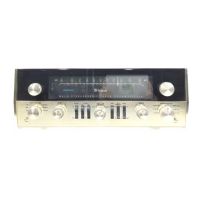Figure 6. MODE SELECTOR.
4. STEREO—The MODE SELECTOR in the
STEREO position connects the left input to
the left loudspeaker and the right input to
the right loudspeaker. This is the normal
stereo position.
5. MONO—The MODE SELECTOR in the
MONO position adds the left input to the
right input and connects the L+R program
to both amplifiers and both loudspeakers.
6. L+R TO L—The MODE SELECTOR in the
L+R TO L position adds the left input to the
right input and connects the L+R program to
the left loudspeaker only.
7. L+R TO
R-The
MODE
SELECTOR
in the
L+R TO R position adds left input to the right
input and connects the L+R program to the
right loudspeaker only.
BASS
Figure 7. BASS Control.
The BASS control is a dual control. The
two parts of the control are concentric. The
center or small knob controls the bass loud-
ness in the left channel. The outer ring con-
trols the bass loudness in the right channel.
The two knobs are friction coupled, this per-
mits them to be adjusted together or inde-
pendently. Turning clockwise increases bass
loudness. Turning them counterclockwise
decreases bass loudness.
TREBLE
Figures. TREBLE Control.
The TREBLE control is a dual control. The
two parts are concentric. The center or small
knob controls the treble loudness in the left
channel. The outer ring controls the treble
loudness in the right channel. The two knobs
are friction coupled. This permits them to be
adjusted together or independently. Turning
clockwise increases the treble loudness.
Turning counterclockwise decreases treble
loudness.
MUTING
Figure 9. MUTING Control.
Muting suppresses the background noise
and hiss normally heard between stations.
With the control in the IN position the muting
is turned on. Weak stations that may not
override noise and interference are also
suppressed by the muting.
In the OUT position, the muting is turned
off. This allows conventional FM tuning with
the noise and interference present. Use this
position to tune weak or noisy stations.
7

